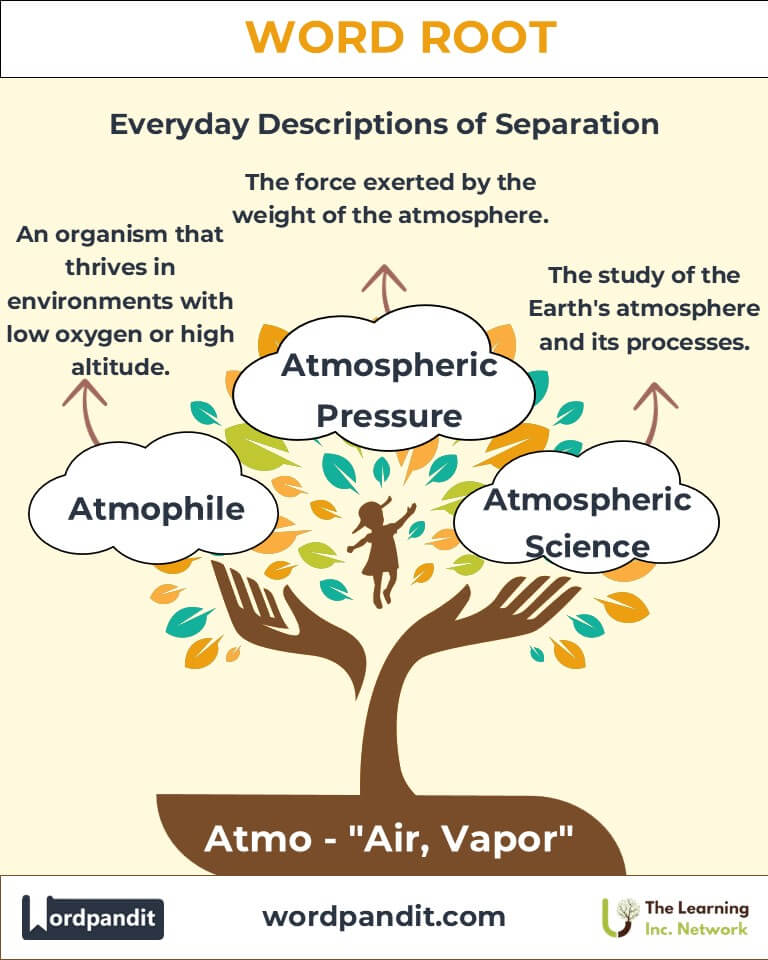Atmo: The Invisible Foundation of Earth's Atmosphere
Dive into the ethereal realm of the word root "Atmo," derived from the Greek word "atmos," meaning vapor. From the life-sustaining atmosphere to cutting-edge atmospheric science, this root forms the cornerstone of words that define the interaction between air, weather, and life itself.

Table of Contents
- Introduction: The Essence of Atmo
- Etymology and Historical Journey
- Mnemonic: Unlocking the Power of Atmo
- Common Atmo-Related Terms
- Atmo Through Time
- Atmo in Specialized Fields
- Illustrative Story: Atmo in Action
- Cultural Significance of the Atmo Root
- The Atmo Family Tree
- FAQs about the Atmo Word Root
- Test Your Knowledge: Atmo Word Root Quiz
- Conclusion: The Living Legacy of Atmo
Introduction: The Essence of Atmo
Imagine a world without the atmosphere—a lifeless sphere devoid of clouds, winds, and the very air we breathe. The word root "Atmo," pronounced at-moh, hails from the Greek "atmos," meaning vapor or steam. This humble root lies at the heart of terms describing air and its movements, connecting disciplines from meteorology to space exploration. Its significance is as profound as the invisible gases that envelop our planet.

Etymology and Historical Journey
The word "Atmo" traces its origins to the ancient Greek word atmos, which means vapor, steam, or breath. Greek philosophers like Aristotle explored concepts of vapor in their study of the natural world, linking "atmos" to the heavens above. In the 17th century, the term "atmosphere" was coined to describe the gaseous layer surrounding Earth. Over centuries, "Atmo" has expanded into various scientific and cultural contexts, symbolizing air, life, and the unseen forces shaping our world.
Mnemonic: Unlocking the Power of Atmo
To remember "Atmo," envision a misty morning where vapor rises and fills the air, blending seamlessly with the environment. This image encapsulates the essence of the root, which represents the ever-present yet invisible layer of gases enveloping our planet.
Mnemonic Device: "Atmo makes the air flow, from vapor to the clouds that glow."
Common Atmo-Related Terms
- Atmosphere (at-muh-sfeer)
- Definition: The layer of gases surrounding a planet.
- Example: "The Earth's atmosphere protects us from harmful solar radiation."
- Atmospheric (at-muh-sfer-ik)
- Definition: Relating to or existing in the atmosphere.
- Example: "Atmospheric pressure decreases with altitude."
- Atmospherics (at-muh-sfer-iks)
- Definition: Radio disturbances caused by natural atmospheric phenomena.
- Example: "The storm generated atmospherics that disrupted the radio signal."
- Atmospherium (at-muh-sfeer-ee-um)
- Definition: A device or space used to simulate planetary atmospheres.
- Example: "The atmospherium at the science center showcases Earth's climate systems."
- Atmometer (at-mom-uh-ter)
- Definition: An instrument for measuring the rate of evaporation.
- Example: "The atmometer recorded high evaporation rates during the drought."
Atmo Through Time
- Atmosphere: Originally used to describe Earth's air layer, the term now extends to the gaseous envelopes of other planets, such as the dense atmosphere of Venus.
- Atmospherics: Once a niche concept in radio communications, it has grown to include environmental science and weather prediction technologies.
- Atmometer: While historically simple, modern atmometers now integrate digital sensors for real-time data.
Atmo in Specialized Fields
- Meteorology: Atmospheric pressure is crucial in predicting weather patterns and storms.
- Space Science: Probes analyze the atmospheres of other planets to search for signs of life or habitability.
- Environmental Science: The study of atmospheric pollution focuses on mitigating climate change and air quality issues.
- Engineering: Devices like atmometers help design efficient irrigation systems by measuring evaporation rates.
Illustrative Story: Atmo in Action
In a small coastal town, young scientist Mia built an atmometer to track evaporation. As sea levels rose, she discovered that rising atmospheric temperatures accelerated water loss, affecting local crops. Mia’s work led to a community initiative to conserve water, demonstrating the profound impact of understanding and harnessing Atmo-related knowledge.
Cultural Significance of the Atmo Root
The concept of "Atmo" transcends science, inspiring art, literature, and philosophy. Poets often romanticize the atmosphere as a metaphor for mystery and life’s fragility. Moreover, cultural traditions across the globe, from ancient rain rituals to modern air pollution awareness campaigns, highlight humanity's enduring relationship with the air we breathe.

The Atmo Family Tree
- Aer (Greek: air)
- Aerial: Relating to the air.
- Aerodynamics: The study of air in motion.
- Hydro (Greek: water)
- Hydrosphere: The watery layer of Earth.
- Hydrology: The study of water.
- Pyro (Greek: fire)
- Pyrosphere: The zone of molten material beneath Earth's crust.
- Pyrometer: Measures high temperatures.
FAQs About " Atmo "
Q: What does "Atmo" mean, and what is its origin?
A: "Atmo" means "air" or "vapor" and originates from the Greek word atmos. It is a root word used in scientific terms related to the atmosphere and processes involving air or gases, such as atmospheric pressure and weather systems.
Q: What is the atmosphere, and why is it important?
A: The atmosphere is the layer of gases surrounding Earth. It is essential for supporting life by providing oxygen, regulating temperature, and protecting the planet from harmful solar radiation. It also plays a crucial role in weather and climate systems.
Q: What is atmospheric pressure?
A: Atmospheric pressure is the force exerted by the weight of the air above a specific point on Earth's surface. It affects weather patterns and is measured using barometers. Low pressure often indicates storms, while high pressure suggests fair weather.
Q: What are the main layers of Earth's atmosphere?
A: Earth's atmosphere consists of five main layers: the troposphere (closest to Earth's surface), stratosphere, mesosphere, thermosphere, and exosphere (outermost layer). Each layer has distinct characteristics and functions, such as weather in the troposphere and the ozone layer in the stratosphere.
Q: What is the greenhouse effect, and how does it relate to "Atmo"?
A: The greenhouse effect is the process where certain gases in Earth's atmosphere trap heat, keeping the planet warm enough to support life. "Atmo" relates to this concept as it encompasses the air and gases involved in this critical environmental phenomenon.
Q: How does "Atmo" influence weather and climate?
A: "Atmo" influences weather and climate by describing the air and gas systems that interact with solar energy, Earth's rotation, and surface features. These interactions drive wind, precipitation, and temperature changes, shaping local and global climates.
Q: What is atmospheric science?
A: Atmospheric science is the study of Earth's atmosphere and its processes. It encompasses meteorology, climatology, and environmental science, focusing on topics like weather forecasting, climate change, and air quality.
Test Your Knowledge: " Atmo " Mastery Quiz
1. What does the root "Atmo" signify?
2. Which layer of the atmosphere contains the ozone layer?
3. What instrument is used to measure atmospheric pressure?
4. What is the main function of Earth's atmosphere?
5. What does atmospheric science study?
Conclusion: The Living Legacy of Atmo
The root "Atmo" reminds us of the invisible forces shaping life on Earth. From enabling scientific exploration to inspiring cultural expressions, it symbolizes humanity’s profound connection to the air we breathe. As challenges like climate change and space exploration evolve, the significance of "Atmo" will continue to grow, uniting science, society, and our shared future under one expansive sky.












